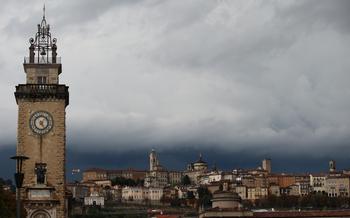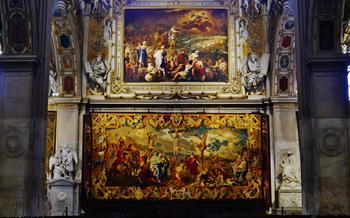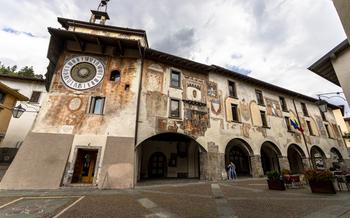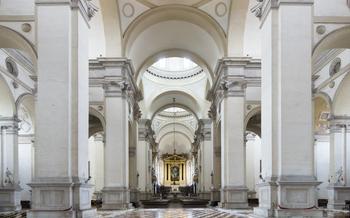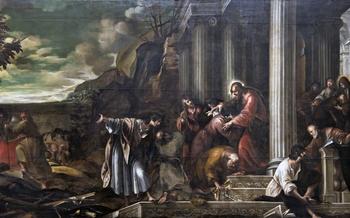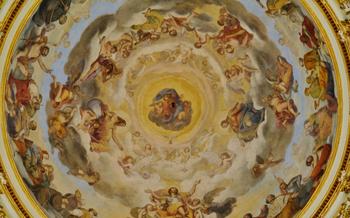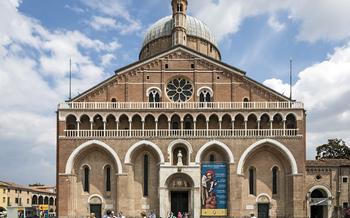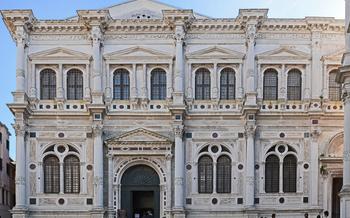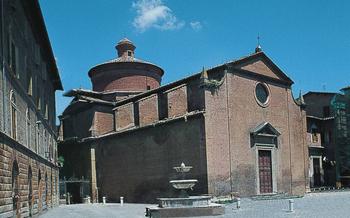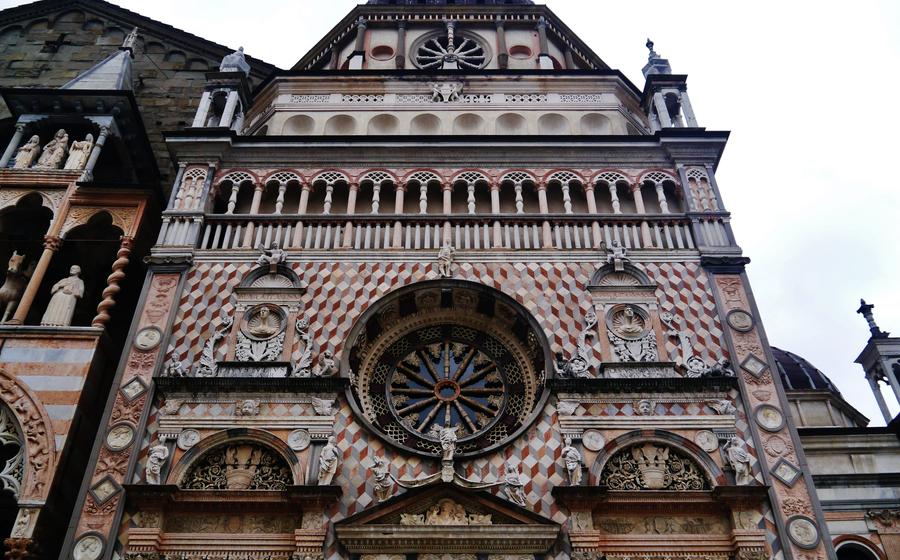
Cappella Colleoni (Colleoni Chapel)
- The Master Behind the Masterpiece
- Architectural Grandeur
- A Journey Through Time
- The Colleoni Chapel's Legacy
- The Altar of Miracles: A Divine Encounter
- Stories in Stone
- Exploring the Neighborhood
- Inside Tips for Visitors
- Unveiling the Colleoni Chapel's Secrets
- Art in Motion
- Echoes of History: Historical Context and Shaping Events
- Preserving a Legacy: The Ongoing Efforts to Conserve and Restore the Cappella Colleoni
- Insider Tip: Unveiling a Hidden Gem
The Master Behind the Masterpiece
Giovanni Antonio Amadeo, a renowned architect and sculptor of the Renaissance era, played a pivotal role in shaping the architectural grandeur and artistic excellence of the Cappella Colleoni. His unique style, influenced by both Gothic and Renaissance aesthetics, is evident throughout the chapel's design and ornamentation.
Amadeo's artistic journey began in his hometown of Pavia, where he honed his skills under the tutelage of renowned masters. His early works showcased his exceptional talent for sculpting, as seen in his contributions to the Certosa di Pavia, a magnificent monastery complex. Amadeo's reputation quickly spread, leading to commissions from prestigious patrons across Italy.
His collaboration with the Colleoni family on the Cappella Colleoni marked a significant chapter in his career. Amadeo's ability to seamlessly blend Gothic and Renaissance elements resulted in a harmonious and visually stunning architectural masterpiece. He skillfully incorporated intricate carvings, sculptures, and symbolic motifs into the chapel's design, creating a cohesive and awe-inspiring space.
Amadeo's artistic genius extended beyond the Cappella Colleoni. His notable works include the facade of the Certosa di Pavia, the Colleoni Chapel in Bergamo, and the tomb of Medea Colleoni in the Basilica di Santa Maria Maggiore in Bergamo. These masterpieces demonstrate his mastery of architectural composition, sculptural detail, and innovative design.
Amadeo's contributions to the Cappella Colleoni and other significant projects earned him recognition as one of the leading artists of his time. His ability to fuse different artistic styles, his technical prowess, and his attention to detail continue to inspire generations of architects and art enthusiasts.
Architectural Grandeur
The Cappella Colleoni stands as a testament to the fusion of Gothic and Renaissance architectural styles. Its exterior design captivates visitors with intricate carvings and ornaments that adorn every surface. The facade is a symphony of sculpted figures, friezes, and bas-reliefs, depicting biblical scenes, mythological creatures, and allegorical figures. These intricate details add depth and texture to the chapel's facade, creating a sense of wonder and awe.
The fusion of Gothic and Renaissance elements is evident in the chapel's pointed arches, ribbed vaults, and elegant pilasters. The ribbed vaults, a characteristic feature of Gothic architecture, soar overhead, creating a sense of height and grandeur. The pilasters, on the other hand, add a touch of Renaissance elegance and sophistication to the chapel's interior.
The chapel's exterior is further embellished with statues of saints, prophets, and biblical figures, each one intricately carved and positioned in niches and on pedestals. These sculptures add to the chapel's visual feast and provide a glimpse into the religious and cultural beliefs of the Renaissance era.
A Journey Through Time
Venturing inside the Cappella Colleoni is like stepping into a sacred timeline, where art and history intertwine. The centerpiece of the chapel is the main altar, a testament to the grandeur of the Renaissance. Its intricate carvings depict scenes from the life of Christ, while the altarpiece, painted by Giovanni Bellini, portrays the Virgin Mary with Saints.
Bartolommeo Colleoni's imposing equestrian statue dominates the chapel's interior. Cast in bronze by Andrea del Verrocchio, the statue captures Colleoni's commanding presence, astride his warhorse. It is a masterpiece that embodies the spirit of the Renaissance, showcasing both artistic skill and military prowess.
Beneath the statue lies Colleoni's sarcophagus, a magnificent work of art in its own right. Sculpted by Amadeo, the sarcophagus features intricate reliefs depicting scenes from Colleoni's life and military campaigns. It serves as a grand memorial to the condottiero, immortalizing his legacy in stone.
The frescoes and murals that adorn the chapel's walls and ceiling further enhance its visual splendor. The works of renowned artists such as Giovanni Battista Moroni and Vincenzo Foppa depict biblical scenes, allegorical figures, and portraits of the Colleoni family. Together, they create a vibrant narrative that transports visitors to a bygone era.
The Colleoni Chapel's Legacy
The Cappella Colleoni has played a pivotal role in the development of Renaissance architecture, leaving an indelible mark on the history of art. Its unique fusion of Gothic and Renaissance elements has inspired countless architects and artists, becoming a model for future religious buildings. The chapel's innovative design and intricate details have served as a source of inspiration for subsequent generations, shaping the architectural landscape of Italy and beyond.
As a testament to its enduring significance, the Cappella Colleoni was designated as a UNESCO World Heritage Site in 2017, recognizing its exceptional universal value. This prestigious designation has solidified the chapel's position as a cultural treasure of global importance, attracting visitors from around the world who come to marvel at its architectural prowess and artistic splendor.
The Altar of Miracles: A Divine Encounter
Hidden within the confines of the Cappella Colleoni lies a sacred treasure, the Altar of Miracles. Enshrined within this exquisite altar is a fragment of the True Cross, believed to possess miraculous powers. Legends whisper of healings and blessings bestowed upon those who seek solace and devotion at this sacred site.
The altar's history is shrouded in mystery and awe. Stories abound of miraculous events and divine interventions that have occurred in its presence. Pilgrims from far and wide flock to the altar, drawn by its reputation for granting wishes and bringing forth miracles.
Artistic depictions and symbolism adorn the altar, each element imbued with profound meaning. Intricate carvings and frescoes tell tales of biblical figures and celestial beings, creating a celestial tapestry that invites contemplation and reverence.
The Altar of Miracles stands as a testament to the enduring power of faith and the belief in divine intervention. It is a place where the sacred and the miraculous intertwine, leaving visitors with a sense of wonder and awe.
Stories in Stone
The Cappella Colleoni is adorned with a wealth of sculptures and reliefs that carry profound symbolic meanings, inviting visitors to decipher their enigmatic messages. Biblical and mythological references abound, with depictions of saints, angels, and mythical creatures. Each element holds a deeper significance, contributing to the chapel's overall narrative.
For instance, the intricate carvings on the sarcophagus depict scenes from the life of Christ, symbolizing Colleoni's devotion and faith. The allegorical representations of virtues and vices serve as moral lessons, reminding visitors of the importance of living a righteous life.
The Colleoni family crest, featuring a lion holding a sword, is prominently displayed throughout the chapel, symbolizing their power and authority. Hidden messages and intriguing details can be found in the carvings, revealing the personal symbolism and aspirations of the Colleoni family.
By unraveling the stories etched in stone, visitors gain a deeper understanding of the chapel's rich iconography and the complex world of Renaissance symbolism. It is an invitation to embark on an intellectual and artistic journey, where every sculpture and relief holds a clue to the chapel's fascinating history and enduring significance.
Exploring the Neighborhood
The Cappella Colleoni is situated in the heart of Bergamo's historic center, inviting you to explore the city's captivating cultural heritage and iconic landmarks. Just steps away lies the enchanting Piazza Vecchia, a medieval square adorned with architectural treasures. Among them, the majestic Palazzo della Ragione, with its elegant loggia and intricate frescoes, stands as a testament to Bergamo's glorious past. Ascend the Civic Tower (Campanone), reaching for the sky and offering breathtaking panoramic views over the city and the surrounding landscapes. Admire the Colleoni Fountain, a graceful tribute to the illustrious condottiero, as it gracefully adorns the square, adding a touch of Renaissance splendor to the surroundings.
Inside Tips for Visitors
To fully appreciate the beauty and significance of the Cappella Colleoni, consider these insider tips for a fulfilling visit:
-
Plan Your Visit: Before your visit, familiarize yourself with the chapel's history, architectural features, and notable works of art. This will help you make the most of your time and appreciate the chapel's grandeur.
-
Guided Tours and Audio Guides: Guided tours are available and offer an excellent way to gain insights and historical context from knowledgeable guides. Alternatively, rent an audio guide for a self-guided tour at your own pace.
-
Photography Guidelines: Photography is generally permitted inside the chapel, but be mindful of restrictions on using flash or tripods. Respect the sacred nature of the space and avoid capturing visitors in your photos.
-
Respecting the Sacred Space: Remember that the Cappella Colleoni is a place of worship and reflection. Be respectful of other visitors, maintain silence, and dress appropriately. Avoid loud conversations or disruptive behavior.
Unveiling the Colleoni Chapel's Secrets
Beyond its artistic and architectural marvels, the Cappella Colleoni holds a treasure trove of lesser-known stories and mysteries. Rumors and legends have swirled around the chapel for centuries, capturing the imaginations of visitors and scholars alike. One persistent tale suggests the existence of hidden chambers and passages beneath the chapel, leading to secret meeting rooms or even a hidden vault.
Another intriguing aspect of the Cappella Colleoni lies in its symbolism and esoteric meanings. Some believe that the chapel's intricate carvings and reliefs hold hidden messages and symbols, known only to a select few. These enigmatic elements have fueled speculation about the involvement of secret societies or the presence of coded messages within the artwork.
Despite the allure of these mysteries, it is important to remember that the Cappella Colleoni remains a sacred space, a place of worship and contemplation. While uncovering its secrets can enhance our understanding and appreciation of the chapel, it is essential to approach these narratives with respect and reverence.
Art in Motion
As you gaze upon the sculptures adorning the Cappella Colleoni, prepare to be mesmerized by the innovative use of perspective and movement. The figures, crafted with exquisite detail, seem to burst forth from the stone, capturing the essence of dynamism and fluidity. This groundbreaking approach to sculpture was a testament to the artistic genius of the Renaissance, and the Cappella Colleoni stands as a testament to this remarkable era.
The sculptures within the chapel are characterized by their dynamic poses and gestures, imbuing them with a sense of energy and vitality. The illusionistic effects created by the skillful use of perspective draw viewers into the scenes, making them feel as though they are part of the narrative unfolding before them. This innovative approach was influenced by Classical art, particularly the works of the ancient Greek sculptor Phidias, whose sculptures embodied perfect harmony and proportion.
The emotional impact of these sculptures is undeniable. The expressive faces and body language of the figures convey a range of emotions, from joy and triumph to sorrow and despair. This skillful manipulation of form and movement allowed the artists to create a powerful emotional connection with viewers, leaving a lasting impression long after they have left the chapel.
Echoes of History: Historical Context and Shaping Events
Nestled amidst the rich tapestry of history, the Cappella Colleoni stands as a testament to the political and cultural currents that shaped its creation. The construction of this architectural marvel coincided with a period of significant transformation in Bergamo and the broader Italian peninsula.
During the 15th century, the Venetian Republic, a powerful maritime empire, held sway over the region. This period of Venetian rule left an indelible mark on Bergamo's urban fabric and cultural heritage. The Venetian influence can be seen in the Cappella Colleoni's graceful Gothic and Renaissance architectural style, mirroring the Venetian Republic's artistic preferences.
The Colleoni family, determined to assert their power and prestige, commissioned the chapel's construction amid the backdrop of political turmoil and conflict. The chapel became a symbol of the family's influence and a testament to their military prowess. The equestrian statue of Bartolommeo Colleoni, the family's most renowned condottiero, epitomizes this martial heritage, capturing the essence of his valor and leadership.
The Cappella Colleoni, therefore, stands as a testament not only to artistic genius but also to the complex historical forces that shaped its creation. It is a monument to the interplay of politics, culture, and personal ambition that characterized the Italian Renaissance.
Preserving a Legacy: The Ongoing Efforts to Conserve and Restore the Cappella Colleoni
The Cappella Colleoni, a masterpiece of Renaissance architecture, has stood the test of time for over five centuries. However, the ravages of time, environmental factors, and human intervention have taken their toll on this architectural gem. Recognizing its invaluable significance, extensive efforts are underway to conserve and restore the chapel to its former glory.
The conservation challenges faced by the Cappella Colleoni are multifaceted. The porous nature of the stone used in its construction makes it susceptible to weathering and erosion. Over time, the intricate carvings and delicate frescoes have been affected by environmental pollution, moisture, and temperature fluctuations. Additionally, past restoration attempts using inappropriate materials and techniques have inadvertently caused further damage.
To address these challenges, a team of skilled conservators and restoration experts has been assembled. Using state-of-the-art techniques and materials, they meticulously clean, repair, and stabilize the chapel's architectural elements. Non-invasive methods are employed to preserve the original fabric of the building, while respecting its historical integrity and artistic value.
The restoration process involves careful documentation, scientific analysis, and collaboration among experts from various disciplines. Conservators work closely with art historians, architects, and engineers to ensure that interventions are informed by a deep understanding of the chapel's history, materials, and construction techniques.
The preservation of the Cappella Colleoni is not merely a technical endeavor; it is a testament to the importance of safeguarding our cultural heritage. By investing in conservation efforts, we ensure that future generations can continue to appreciate and marvel at this architectural masterpiece. Through the dedication and expertise of conservators, the legacy of the Colleoni family and the artistic genius of Giovanni Antonio Amadeo live on, inspiring and captivating visitors for centuries to come.
Insider Tip: Unveiling a Hidden Gem
Beyond the main attractions of the Cappella Colleoni lies a hidden gem that offers visitors a unique perspective and a moment of tranquility. Tucked away from the hustle and bustle, a secluded courtyard or terrace awaits discovery. This hidden spot is an oasis of peace, providing panoramic views of the surrounding cityscape and the distant hills.
As you step into this serene space, you'll be greeted by a breathtaking vista that stretches far and wide. The rooftops of Bergamo's historic buildings create a picturesque tapestry, while the distant mountains add a touch of grandeur to the scene. The courtyard's secluded nature offers a respite from the crowds, allowing you to fully immerse yourself in the beauty of the surroundings.
Whether you choose to bask in the warmth of the sun or seek refuge from the heat, this hidden spot is the perfect place to pause, reflect, and savor the moment. Let the tranquility of the courtyard wash over you as you contemplate the artistic wonders of the Cappella Colleoni and the rich history that surrounds it.
